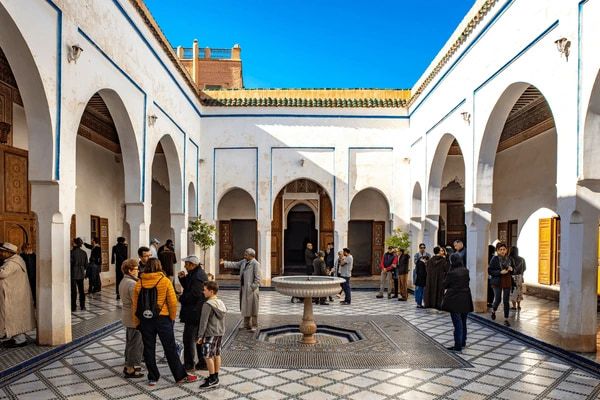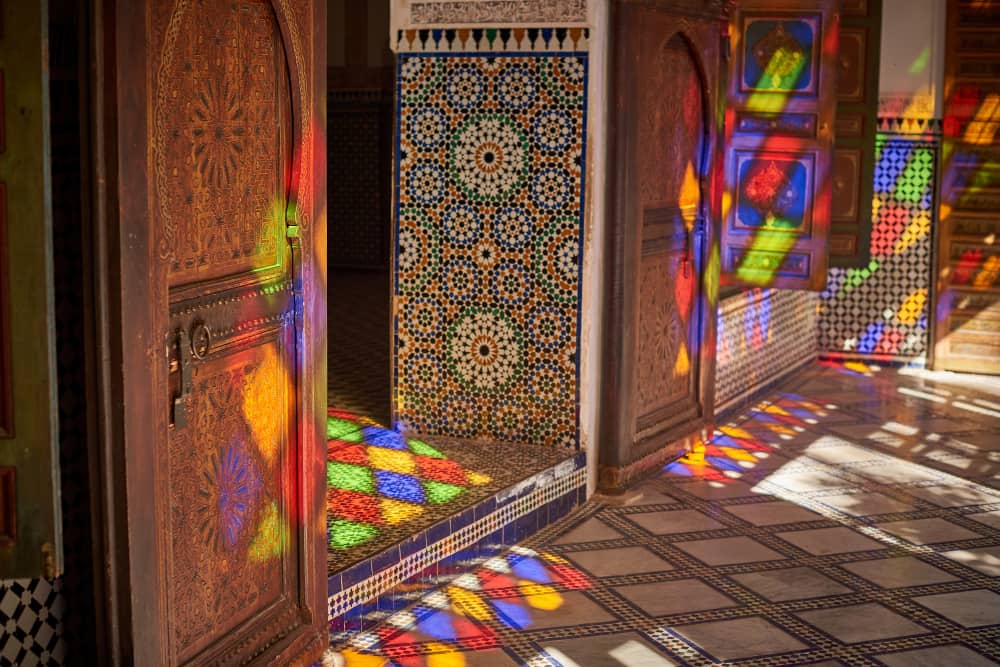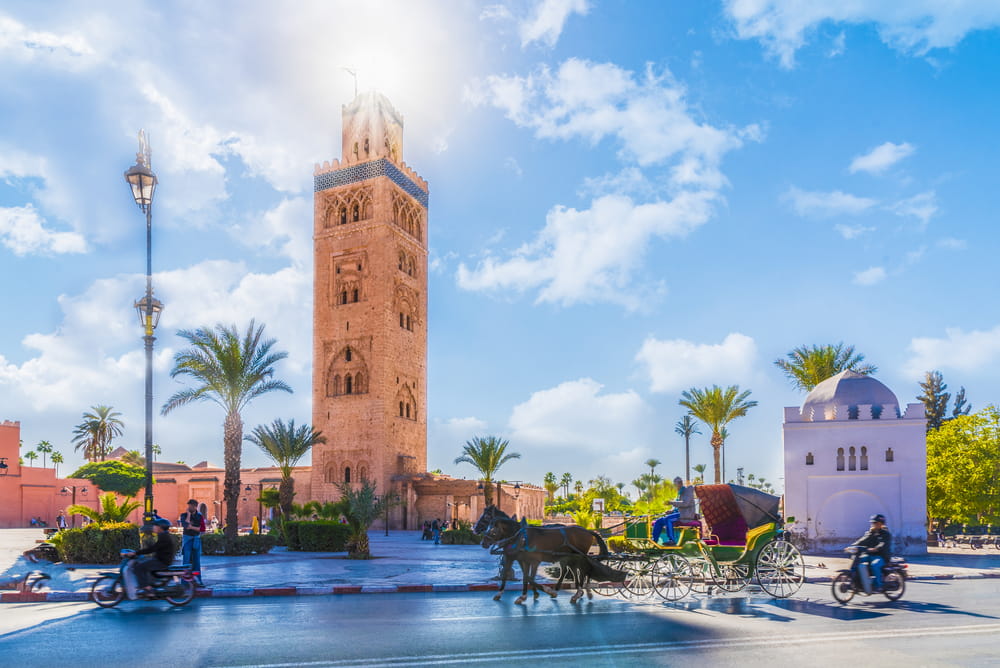Bahia Palace is one of the most stunning and historic places to visit in Marrakech, Morocco. Known for its beautiful architecture and fascinating history, this palace offers visitors a look into Moroccan royal life. Built in the 19th century, Bahia Palace was designed to be a grand, luxurious residence, showcasing the best of Moroccan and Moorish design.
As you walk through its halls and courtyards, you’ll see intricate geometric patterns, detailed cedar wood carvings, and spacious gardens that reflect the rich culture and artistry of the Alawi dynasty. Each room and courtyard is a piece of art, with unique designs crafted by skilled artisans. From the Cour d’Honneur (Honor Court) to the colorful Riad gardens, every corner of Bahia Palace tells a story.
This guide will help you explore Bahia Palace in the best way possible. You’ll learn about the best time to visit, the history behind this historical monument, the unique design features, and more. Let’s start with when to visit Bahia Palace to make the most of your experience.
Table of Contents
When to Visit Bahia Palace

Timing your visit to Bahia Palace can truly enhance the experience. Marrakech enjoys a generally warm climate year-round, but each season offers a different perspective of the palace. The best months to visit are March to May in spring or September to November in fall. During these seasons, temperatures are moderate, often ranging from 18°C to 28°C (64°F to 82°F), ideal for wandering the palace’s courtyards and gardens without feeling overwhelmed by heat.
In summer, temperatures can soar above 38°C (100°F), making it challenging to fully enjoy the palace’s outdoor areas. For those visiting in the hot summer months, it’s wise to arrive early, around the opening hour of 9 a.m., or closer to closing time in the late afternoon, to experience cooler temperatures and fewer crowds.
The palace remains open daily, typically from 9 a.m. to 5 p.m., though hours may vary on national holidays. An entrance fee is required, usually a small cost for the experience it offers. Guided tours are often available on-site or can be booked in advance. These tours enrich the visit with historical insights and details that may be missed when exploring alone. Tours typically last about an hour and are well worth the additional fee for history enthusiasts. Visitors should also be prepared for possible lines at popular visiting times, as Bahia Palace is a top tourist attraction.
The History of Bahia Palace
Bahia Palace was originally commissioned by Si Moussa, the Grand Vizier to Sultan Muhammad ibn Abd al-Rahman, in the late 19th century. Intended to be a grand residence for his family, Si Moussa envisioned the palace as a symbol of wealth, beauty, and authority. After his death, his son Bou Ahmed expanded the palace even further, transforming it into a royal residence. Bou Ahmed, also a vizier, was a former slave who rose to great power, and his influence is seen in the grandeur of Bahia Palace.
Bou Ahmed invested in the finest materials, including cedar wood from the Atlas Mountains, Italian Carrara marble, and tiles that were hand-painted by local artisans. The palace took over a decade to complete, and it was known as one of the most luxurious residences of its time, embodying the Moroccan dream of beauty, power, and sophistication.
Under the French Protectorate in the early 20th century, the palace was used by French officers, including General Lyautey, who added French touches to the Moroccan design. These influences remain today, blending French and Moorish elements in a unique architectural harmony. This mix of cultures, along with the Alawi dynasty’s rich heritage, makes Bahia Palace not only a historical monument but also a representation of Morocco’s layered history.
Design, Architecture, and Construction of Bahia Palace

Bahia Palace is a masterpiece of Moroccan, Moorish, and Andalusian architectural styles. The palace’s layout, with interconnected riads, expansive courtyards, and lush gardens, reflects traditional Islamic architecture, which focuses on harmony, balance, and beauty. Each courtyard and room is unique, featuring geometric patterns, vibrant tilework, and intricately carved cedar wood, showcasing the talent and skill of Moroccan artisans.
The Grand Riad and Petit Riad are two of the palace’s main sections, both with their stunning courtyards. The Grand Courtyard, also known as the Cour d’Honneur, is the heart of the palace. It features expansive Italian marble floors, reflecting pools, and tall cedar wood doors that lead into different sections of the palace. This courtyard was designed to impress visitors and is an excellent example of how Moroccan palaces were made to showcase power and luxury.
One of the most iconic design elements is the use of zellige tiles, small, hand-cut tiles that form intricate patterns, often with floral or geometric designs. These tiles cover walls, floors, and fountains, creating a feeling of movement and depth in each room. The ceilings are equally impressive, painted and carved to display traditional Moorish motifs, and often made from cedar wood that fills the palace with a faint, pleasant aroma.
The Riad gardens add another layer of tranquility to the palace. Filled with plants, fountains, and shaded walkways, these gardens offer a refreshing contrast to the bustling city outside. The design combines open spaces with enclosed areas, allowing light to flow through and creating a sense of peace and privacy. The mix of nature with architecture enhances the palace’s feeling of harmony and balance.
Where to Stay Near Bahia Palace
Choosing the right accommodation near Bahia Palace allows you to explore the area conveniently and comfortably. For a luxurious experience, hotels like La Mamounia and Royal Mansour offer more than just a place to stay. These high-end hotels are masterpieces in their own right, featuring Moroccan-inspired decor, large pools, spa facilities, and award-winning restaurants. Both are located within a short drive of Bahia Palace, providing easy access to the historical sites while offering unparalleled comfort.
For those seeking a more traditional experience, staying in a riad is a fantastic option. Riads like Riad Dar Anika and Riad Les Bougainvilliers offer a charming, authentic atmosphere. These Moroccan homes typically have a central courtyard filled with plants and fountains, giving guests a quiet and cozy space to relax. Riads usually serve traditional Moroccan breakfasts and offer a unique glimpse into local architecture and lifestyle.
If you’re traveling on a budget, there are several guesthouses and small hotels in the area, offering basic amenities but ensuring a comfortable stay. Many budget options are family-run, providing a warm, welcoming environment that can make you feel like part of the local community. Staying close to Bahia Palace also makes it easy to explore nearby attractions, souks, and dining spots, making it an ideal choice for travelers who want to fully immerse themselves in Marrakech.
Where to Eat Near Bahia Palace
Marrakech is known for its flavorful food, and the area around Bahia Palace offers plenty of options to satisfy your taste buds. For a traditional Moroccan meal, Dar Yacout is a top choice. The restaurant serves classic dishes like lamb tagine, couscous, and Moroccan salads in an elegant setting that feels like stepping into a royal dining room. Another excellent option is Nomad, which combines traditional Moroccan flavors with modern twists and is located in the heart of the Medina.
For a casual dining experience, Café des Épices is a lively spot perfect for a quick meal or a refreshing mint tea. Located in the bustling souks, it offers views of the markets and the people who bring them to life. Pâtisserie Amandine, a bakery nearby, specializes in both French and Moroccan pastries, making it an ideal stop for dessert or an afternoon snack.
If you’re interested in fusion cuisine, Le Jardin offers a unique menu that blends Moroccan and international dishes. The garden setting, with lush greenery and soft lighting, creates a calm atmosphere ideal for unwinding after a day of sightseeing. Each of these dining spots offers something different, giving you a taste of both traditional and modern Moroccan cuisine.
Activities and Experiences Near Bahia Palace
Bahia Palace is located in the vibrant Medina of Marrakech, and there are plenty of activities nearby to enhance your visit. Start by exploring the Medina itself, a maze of narrow alleys filled with souks. These traditional markets are bustling with life, offering everything from handmade carpets and leather goods to spices and jewelry. Visiting the souks is a chance to see Marrakech’s rich craft traditions and to pick up a unique souvenir.
Just a short walk away, you’ll find El Badi Palace, a 16th-century palace that is mostly in ruins today but still grand in scale and design. Visitors can wander through the vast courtyards and even climb to the top of the walls for views of Marrakech. Nearby are the Saadian Tombs, a resting place for members of the Saadian dynasty, decorated with intricate carvings and zellige tilework.
For nature lovers, Jardin Majorelle is a must-visit. This botanical garden was restored by the designer Yves Saint Laurent and features exotic plants, fountains, and iconic cobalt-blue buildings. It’s a peaceful retreat from the city’s busy streets and offers a different side of Marrakech’s beauty. Together, these activities and landmarks provide a mix of cultural, historical, and natural experiences near Bahia Palace.
Nearby Landmarks and Attractions

Several major landmarks are located close to Bahia Palace, making it easy to explore Marrakech’s most famous sites in one day.
- Koutoubia Mosque, the largest mosque in Marrakech, is known for its beautiful minaret that towers over the city. This minaret influenced the design of other mosques in North Africa and is a key example of Islamic architecture.
- Jemaa el-Fnaa, the main square, is a vibrant gathering place and a UNESCO World Heritage site. By day, it is filled with juice vendors, snake charmers, and market stalls. At night, the square transforms into a lively food market with street performers, musicians, and traditional storytellers. It’s one of the best places to experience the daily rhythm and unique culture of Marrakech.
- The Ben Youssef Madrasa, a former Islamic school, is another nearby landmark. It features stunning architecture with detailed carvings, a large courtyard, and dormitory rooms where students once lived. Each of these sites adds depth to your understanding of Marrakech, combining elements of religion, education, and local traditions.
Essential Tips for Visiting Bahia Palace
To make the most of your visit to Bahia Palace, it’s helpful to prepare in advance.
- Dress Modestly: Show respect for Moroccan customs, especially in religious or historic sites.
- Comfortable Shoes: Essential for exploring the large courtyards and gardens, as some areas have tiled or uneven floors.
- Photography: Allowed in most areas, but watch for signage indicating restrictions.
- Essentials: Bring water, sunscreen, and a hat, especially if visiting in warmer months.
- Cash Payments: Recommended for purchasing tickets, as some locations may not accept credit cards.
Learning a few basic Moroccan Arabic phrases, such as “shukran” (thank you), can be appreciated by locals. If you’re interested in a deeper understanding of the palace, consider hiring a guide to share stories about the history, architecture, and cultural significance of Bahia Palace.
Conclusion
Bahia Palace is a remarkable destination in Marrakech, offering visitors a glimpse into the elegance and history of Moroccan architecture. As you explore its courtyards, intricate tilework, and lush gardens, you’re surrounded by the craftsmanship and cultural heritage that make this palace a masterpiece. Visiting Bahia Palace is more than a sightseeing experience; it’s a journey into the past, revealing the beauty and complexity of Moroccan royal life.
Beyond the palace itself, the surrounding area in Marrakech’s Medina is vibrant and full of life. From nearby historical sites like Koutoubia Mosque and El Badi Palace to the lively Jemaa el-Fnaa square, there’s much to discover. Each place adds depth to the story of Marrakech, making a trip to Bahia Palace the perfect starting point for exploring the city’s rich history, culture, and architecture.
Whether you’re an art lover, a history enthusiast, or simply a curious traveler, Bahia Palace and the nearby attractions offer a truly immersive experience. Plan your visit well to enjoy every aspect of this historic landmark and the captivating city of Marrakech. The memories and insights you gain here will make your journey to Bahia Palace unforgettable.
FAQs
How long does it take to visit Bahia Palace?
Most visitors spend about 1 to 2 hours exploring the palace, but you can take longer if you want to enjoy all the details.
Is Bahia Palace wheelchair accessible?
While some parts are accessible, there are areas with uneven floors and steps. Accessibility may be limited in certain sections.
Can you take photos inside Bahia Palace?
Yes, photography is allowed in most areas, though some rooms may have restrictions. Look for signs indicating no photography zones.
Are there restroom facilities at Bahia Palace?
Yes, there are restrooms available for visitors within the palace grounds.
Is there parking near Bahia Palace?
Parking options are limited near the Medina. It’s best to arrive by taxi or other public transportation.
